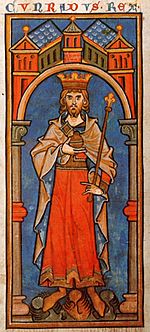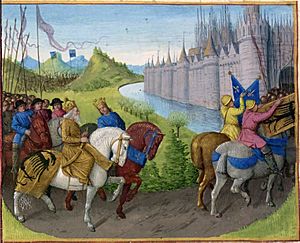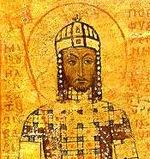Battle of Constantinople (1147) facts for kids
Quick facts for kids Battle of Constantinople (1147) |
|||||||
|---|---|---|---|---|---|---|---|
|
|||||||
| Belligerents | |||||||
| Byzantine Empire | German crusaders (Holy Roman Empire) | ||||||
| Commanders and leaders | |||||||
| Prosouch, Basil Tzikandyles (Manuel I in overall command) | Unknown (Conrad III in overall command) | ||||||
| Strength | |||||||
| Unknown – described as smaller than the German force by Byzantine historian John Kinnamos | Unknown – Only part was involved, the entire German army had 20,000 combatants | ||||||
| Casualties and losses | |||||||
| Unknown | Unknown (possibly heavy according to Michael Angold) | ||||||
The Battle of Constantinople in 1147 was a big fight. It happened between the army of the Byzantine Empire and German crusaders. These crusaders were part of the Second Crusade and were led by Conrad III of Germany. The battle took place just outside the Byzantine capital city, Constantinople.
The Byzantine emperor, Manuel I Komnenos, was worried. A large, uncontrolled army was very close to his city. Another big French crusader army was also coming. Emperor Manuel feared that these two armies might join up near Constantinople. After some smaller fights and disagreements with Conrad, Manuel gathered some of his soldiers. He placed them outside the walls of Constantinople. A part of the German army then attacked and was defeated. Historians say they lost many soldiers. After this loss, the crusaders agreed to be quickly moved across the Bosporus strait to Asia Minor.
This battle wasn't super important for the whole war. But it's special because old records describe the Byzantine army's plan in great detail. This is rare for that time.
Contents
What Led to the Battle?
The Second Crusade (1145–1149) began because of Pope Eugenius III. He called for it after the County of Edessa was captured by a Muslim leader named Zengi. The County of Edessa was a Christian area set up during the First Crusade.
This Second Crusade was the first one led by kings. These kings were Conrad III of Germany and Louis VII of France. Their armies marched separately across Europe. After entering Byzantine lands in the Balkans, both armies headed towards Constantinople. The crusaders planned to then travel by land across Asia Minor to reach the Holy Land.
Conrad had upset Emperor Manuel. He called Manuel "King of the Greeks" instead of his proper title, "Emperor of the Romans." The Germans also acted like they were more important than the Byzantines. This made Manuel trust them less than the French.
German leaders promised not to harm the Byzantine Empire. So, Manuel arranged for markets to feed the crusader army. A Byzantine force, led by the skilled general Prosouch, watched the Germans. There was a small fight near Adrianople. The Byzantines pushed back an attack by Conrad's nephew, Frederick Barbarossa. The crusaders also faced a natural disaster. A sudden flood swept away part of their camp, killing many people.
Manuel wanted the crusaders to cross to Asia Minor using the Hellespont. This would keep them away from Constantinople. But the Germans ignored his advice. They arrived near Constantinople on September 10. Manuel had already fixed and strengthened his city walls. This was to protect against any crusader attack.
The Germans camped near a palace called Philopatium. But they looted it so much that it became unlivable. Then they moved to another palace, Pikridion. The crusaders might have been low on food. They started stealing from and attacking the local people. Manuel was determined to get the Germans across the Bosporus quickly. He moved some of his soldiers to make them leave.
The Battle Begins
The Byzantine army was led by two generals, Prosouch and Basil Tzikandyles. They were told to stand and face the Germans. Their presence was meant to provoke an attack. The Byzantine army was smaller than the crusaders'. But, as the historian John Kinnamos wrote, it was "equally superior in military science and perseverance in battle."
Prosouch and Tzikandyles had watched the German army earlier. They told Emperor Manuel that the Germans were strong and well-armored. But their cavalry (soldiers on horseback) were not fast. They also lacked discipline.
Kinnamos described the Byzantine army's setup in detail. At the very front were four units of "the most unwarlike, common part of the army." These were likely foot soldiers. Behind them were the heaviest and best-armored cavalry, called kataphraktoi. These were the army's elite fighters. Next were "those who rode swift horses," the koursores. These were faster cavalry for close combat. Finally, at the back were the Cumans, Seljuk Turks, and the "Romans' archer force." These were probably all archers on horseback.
This formation was unusual for a big battle. It was almost the opposite of how Byzantines usually fought. For example, at the Battle of Sirmium in 1167, horse archers were at the front. They would skirmish with the enemy. Heavy cavalry was at the front of the main army. Foot soldiers were kept at the back as a reserve.
Historian John Birkenmeier says this setup was for this specific battle. The Byzantines knew the area well. It was right outside Constantinople's walls. They also knew where the Germans were. So, they didn't need horse archers to scout or screen. This setup was more like the one Alexios I Komnenos used at the Battle of Philomelion in 1117. There, foot soldiers stopped enemy attacks. This let the cavalry make controlled counter-attacks from behind the foot soldiers. Also, lighter-armed troops at the back could cover a retreat or push a victory.
According to Kinnamos, the part of the crusader army facing the Byzantines "attacked at a run." They were "seized by a great eagerness and disorder." A fierce battle began. The Byzantines "scientifically resisted and slew them" in response to the Germans' reckless attack. A poem praising Manuel I says the Cuman horse archers played a big part in the fight. The Germans lost many soldiers.
Not all of the German crusader army was in this battle. King Conrad was with another, possibly larger, part of his army. He was quite far away. So, he didn't find out about his troops' defeat for some time.
What Happened Next?

The Byzantines' show of military strength convinced Conrad. He agreed to Manuel's wishes. The main part of his army was quickly moved across the Bosporus to Damalis. Manuel's biggest worry was gone. The German and French crusader armies would not combine right outside his capital.
With the Germans safely in Asia, Manuel started talking with Conrad again. Manuel wanted Conrad to promise to return any land they conquered that used to belong to Byzantium. But Conrad didn't want to agree. Manuel offered Conrad an alliance, but Conrad refused.
The German crusaders then marched into Anatolia (modern-day Turkey). They didn't have Byzantine guides or enough supplies. The crusaders later claimed their guides were helping the Seljuk Turks. Near Dorylaeum, they met the Seljuk sultan's forces. The crusaders were half-starving and had to retreat. The Turks attacked the retreating crusaders, and the retreat became a complete defeat.
The German army met the French army at Nicaea. The combined crusader force then took the coastal road towards Attaleia. Even though this was Byzantine land, the Turks kept attacking the crusaders. It was said that local Greek people also helped the Turks.
Most of his army marched to Attaleia. But Conrad took a ship with his group from Ephesus and sailed back to Constantinople. Manuel welcomed him grandly. He even personally helped Conrad when he fell ill. The two leaders became friends again. They arranged a marriage between their families. Manuel then agreed to ship Conrad's smaller army to Palestine. The Second Crusade ultimately failed there. They were defeated outside the walls of Damascus.
See also
Sources
Primary
- 'Manganeios Prodromos': a collection of praise poems for Manuel I.
Secondary
- Harris, Jonathan (2013) Byzantium and the Crusades, 2nd Edition.



